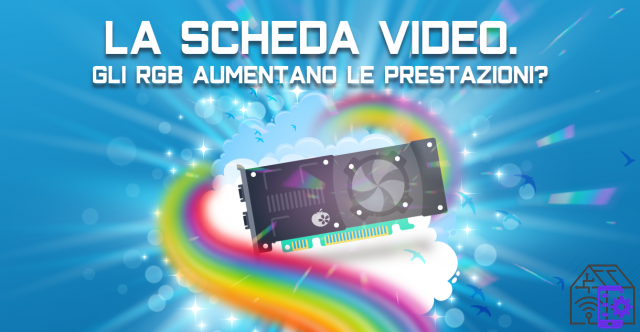
Hello to all friends of and welcome back to the guide that helps you to choose, understand and assemble your custom PC. I remind you that this is the fifth appointment in our column and that in the previous ones we have learned about the processor, the motherboard, the RAM and the disks.
ALL EPISODES:
Chapter 1: Guide to building your assembled PC: THE BASICS
Chapter 2: Guide to building your assembled PC: PROCESSOR AND HEAT SINK
Chapter 3: Guide to building your assembled PC: THE MOTHERBOARD
Chapter 4: Guide to building your assembled PC: RAM, HDD and SSD M.2
Chapter 5: Guide to building your assembled PC: THE VIDEO CARD
Chapter 6: Guide to building your assembled PC: THE POWER SUPPLY
Chapter 7: Guide to building your assembled PC: THE CASE
Today we finally have HER, the most desired, the most expensive, the most energy-consuming, the most fascinating of the computer components: the Video Card!
Let's go immediately to see what it is for, because it is talked about a lot and above all if:
The video card. Do RGB increase performance?
It sounds like a stupid question… and indeed it is! Indeed no, it depends on how we interpret the question in reality.
As we have already seen for some of the previous components the fact that it is super illuminated does not lead to better performance, or at least it does not directly depend on that. If anything, we can say that the RGB component is often the prerogative of the most expensive, most beautiful and ergo more powerful cards.
So in a certain sense YES, the cards that make the lights, in addition to being more tamarre and more pleasing to myself and to all the gamer friends of the undergrowth, practically always coincide with the most powerful and performing models.
But who is this video card really, what is its function in our computer, why do they cost so damn much, and above all: what happened to Carmen Sandiego ?!
The video card shapes the digital world.
Unfortunately I can't help you about Carmen, but about everything else, yes!
La Video Card (aka VGA) is that component of our computer that transforms the information that comes from the processor into images. The relationship between the card and the CPU, as we will see, is very close, so much so that together they constitute the main components on which to design the rest of the computer, especially when it comes to machines designed for gamers.
To better understand how this component works and why it costs more than a boat full of V-bucks, let's take a closer look at it.
A PC in the PC. CPU is to GPU as RAM is to VRAM
That's right, a video card can be thought of as a small computer that specializes in graphics tasks. It has its own content processing processor, the But by the full GPU acceleration tech precisely (Graphics Processing Unit), and its volatile memory VRAM (Video RAM), all plugged into the printed circuit board PCB (Printed Circuit Board) which is nothing more than its motherboard.
Also, like the eye of Sauron and all other computer components, video cards also produce a lot of heat: that's why we have a series of dissipating elements made up of lamella metallic, heat pipe e fans that direct and dissipate the heat generated to keep the card always fresh and performing.
Some models even integrate liquid coolers with connected radiators or arrangements for custom loops.
Given the large amount of information to communicate with the processor, the video card needs the fastest port of the whole motherboard, namely the 16x PCIe port.
Then after receiving the instructions from the CPU, the video card processes the images by creating the shapes, filling them with colors, applying light and shadow effects, and finally adding filters to improve their final quality.
Once this is done, it sends all the information to the last link in this chain: the monitor. Here is finally the graphic rendering that our game or program has requested and our elaborate system.
Whether it's 3D Studio Max, Battlefield 5, or videos of cute and cuddly hugging kittens, the images are sure to go through the video card… right?
Mistaken!
In fact, in some computers the image processing is not entrusted to a specialized card, but takes place directly inside the processor itself, with obviously less performing results. These CPUs are called processors with integrated video graphics.
A good example of this are Intel processors and the latest AMD Ryzen G.
How do I choose the video card?
Yep, how do we choose the right video card for us?
How is a gaming model different from a professional model?
Well, such a clear distinction as in the past, where there were cards dedicated to work and others dedicated to play, no longer exists. In fact, a few years ago NVIDIA framework and AMD's FirePro they represented the proposals specialized in work fields. Currently, however, the "consumer" cards have become so powerful and precise that they are preferred and used by both gamers and professionals. In choosing a VGA, therefore, we are simply based on some common factors that represent the three fundamental variables for evaluating the graphics performance of our machine, namely the resolution,updating and image quality.
Let's start with the last one. The image quality is processed by our hardware, but it is mainly managed and optimized by our software. Especially within the games we have the possibility to improve the images and their movement by applying filters that allow us to obtain more realistic shadows, less jagged edges and more defined reflections.
These techniques mainly concern the techniques of Anti-Aliasing and search for typological numbers (TAA, FXAA, MSAA, SSAA and the most recent DLSS which is based on artificial intelligence systems).
For digital professionals, however, the most important variable is the resolution.
Photographers, designers and architects as you know work only on 40 "monitors, in 1000m2 lofts in downtown Brooklyn ... Even the less fortunate professionals, or those located outside the confines of the city of New York, need to see and process images with a high level of detail. This is why this parameter is vital: the resolution is simply the number of PX (pixel) that we physically find on our monitor and recompose the mosaic of the image. The higher the number, the greater the definition of the image.
The ability to process very defined frames is therefore another parameter on which to base your choice. If we talk about still images, in reality, all cards, even the cheapest ones, are capable of generating frames in 4K. The greatest difficulty is rather in generating them very quickly, introducing the last variable: updating the image.
In fact, if you are a video game lover, the refresh rate, or refresh rate, represents the benchmark and translates as the amount of frames that our computer processes and shoots towards the monitor.
The most common panels usually travel at 60hz (i.e. 60 updates per second), but the most performing and professional ones go up to 120, 144, 165 and 240hz and, video card permitting, return a more fluid movement. The TVs, on the other hand, have refreshes blocked at 60hz, much more rarely at 120, but in any case with response times that are always quite disappointing, making them unsuitable for competitive gaming.
Be that as it may: the more powerful our video card is (and supported by an adequate CPU and amount of RAM) the more it will be able to generate FPS (frame per second). However, this is not enough, because often the FPS generated by the PC and the HZ (hertz) with which the monitor updates are not synchronized, generating defects and image distortions.
In the event that the aforementioned components are not balanced, we could also run into problems of bottleneck, situations in which, for example, the power ratio between video card and processor is so unbalanced that it is unable to fully exploit the power of our hardware or even create interruptions and slowdowns to the system.
Stuttering and Tearing are an example, i.e. an irregular update in the flow of frames in the first case and an image literally cut in two different moments of the game in the second.
To overcome this type of problem, the VSync, that is, a forced limitation of the number of frames of the video card to that of the monitor. However, this limits but does not completely solve the problems because the first of the 60fps of the computer, for example, may not be synchronized with the first of the 60hz of the screen.
NVIDIA e AMD however, representing Oliver Hutton and Mark Lenders of the video card market, they have developed and distributed two different technologies for the definitive resolution of the problem. On the one hand we have indeed NVIDIA G-sync, ie the introduction of a dedicated hardware component inside the monitors that dynamically manages the increase or decrease in the number of frames depending on the delivery of the computer's fps. Similarly, theAMD FreeSync it doses and distributes these frames, but does so at a software level and with the adoption of open and free standards. As a result, FreeSync monitors are always cheaper than G-Sync ones.
NVIDIA vs AMD. The NeverEnding Story
A very important piece that we lack for the choice of the video card is the knowledge of the brand and the models that we can find on the market.
AMD, already Intel's antagonist with the CPUs, this time crosses the gloves in the ring of the VGA market with NVIDIA. On the one hand we have the AMD Radeon, and on the other the NVIDIA Geforce with different technologies and software, but with the same intent: to battle with video games and 3D renderings.
Both cards exploit parallelization techniques, i.e. the execution of many small simultaneous calculations entrusted to specific and microscopic calculation units made up of the individual core ("Core" in fact) inside the aforementioned GPU. The higher the number of CudaCore (for NVIDIA) and Stream Processor (for AMD) the more performing will be, especially in working activities, our video cards.
If you are wondering, the answer is no: a unique correspondence between the two types of cores does not exist and, to verify the exact difference in performance in a specific game or work activity, the only way is to rely on targeted benchmarks. available in the magical www, or on YouTube.
Another feature common to both houses is the possibility of creating multi GPU configurations, i.e. inserting multiple video cards in the same computer that work simultaneously. But be careful, because only the costs are doubling, given that the performance of a configuration NVIDIA SLI o AMD Crossfire, in addition to requiring a specific motherboard compatibility, they return a performance increase of up to 50/60% in the most optimistic of situations.
Then we have the discussion related to DirectX e OpenGL, or software libraries developed by third parties (Microsoft in the first case, SGI in the second) for the creation of 2D and 3D graphic models, used by video cards in drawing images; and that relating to the latest discovery of science that would make even Dr. Neo Cortex rub his hands, namely the Ray Tracing.
While the two libraries can be considered universal, even if different in use and supported indiscriminately by NVIDIA and AMD, the Ray Tracing real time, that is a complex technique already used in cinematography that takes into account the light sources within the game scene for an ultra-realistic graphic rendering, is for now the prerogative of NVIDIA alone with the recent release of the models RTX.
Finally we have the customization by the manufacturers, that is, customizations of the Reference design, which is the base model produced directly by NVIDIA and AMD, which is revised by manufacturers such as Asus, MSI, Gigabyte e Zotac, just to mention the main ones, in factors such as size, cooling system, GPU frequencies and consumption.
In addition to the slightly different performance of model and model, what often tip the scales is the aesthetic factor or, secondly, the compatibility of RGB with the proprietary systems of individual houses (Aura sync at Asus, Mystic light at MSI e RGBFusion of Gigabyte).
VGA, DVI, DISPLAY E HDMI.
Okay, let's say you are a parent and you want your first child in the height of adolescence a little less strolling around and a little more at home.
Here, one of the best ways is certainly to provide it with a gaming PC and Fortnite.
All this, however, in addition to a good video card, would not be possible if there were not a cable and a monitor on which, together with the RGB, also the contorted faces of a competitive trans from video game are reflected.
Seriously, the monitor as we have seen defines a fundamental component in the choice of the video card, so much so that sometimes the purchase is subordinated.
Last but not least, let's see how the VGAs interface externally and which type of cables produces the best performance in play and work.
Two very common old standards are analog connections VGA (Video Graphics Array), and digital DVI (Digital Visual Interface). Both do not manage the audio component and we can consider them outdated technologies.
In the vast majority of cases on cards and monitors we will find instead HDMI (High-Definition Multimedia Interface) e DisplayPort, two standards that allow the transmission of audio and video in high quality within the same cable. In versions 1.2 DisplayPort e 2.0 of HDMI, these two cables in fact support transmissions in 4K up to 60hz, a value that will rise further in the future with the commercialization of HDMI 2.1 with the mind-boggling capacity of 8K to 120hz (going from 18 to 48 gigabits per second of information).
OK perfect! Now that we know all the theory, let's get your fingertips warmed by checking out our video card recommendations by price range!
500 € configuration - Nothing at all!
In the basic configuration, unfortunately, we do not have enough budget to afford a video card and we will have to rely on the good graphics performance integrated on the processors examined in the second article, that is the Ryzen 5 2400G e l’Intel i3 8350K.
The performance is not bad considering the price and in game we can get values even around 60fps in FullHD in less resource-intensive games such as Fortnite, however, bringing the graphic details to a minimum. To achieve similar results in heavier games we must necessarily lower the game resolution to HD 720p, otherwise we will see a sharp drop in FPS. Even in the workplace, the two CPUs do not perform badly and for an intensive use of basic programs such as Office or Internet browsing, but also for watching movies or light photo editing, the power is more than enough.
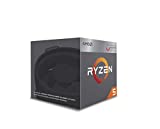 AMD Ryzen 5 2400G 3.6GHz 2MB L2 Box processor - Processors...
AMD Ryzen 5 2400G 3.6GHz 2MB L2 Box processor - Processors...
- ATTENTION! Check the compatibility of the product before buying it!
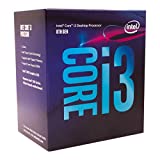 Intel BX80684I38100 Cpu Processor, Silver
Intel BX80684I38100 Cpu Processor, Silver
- Computer memory type: ddr4_sdram
1000 € configuration - FullHD does not scare us!
Finally the first models! For AMD we have Sapphire Radeon RX 590 and for NVIDIA the new Gigabyte GTX 1660, two cards that will allow us to play in FullHD at maximum detail, managing to remain almost always above the famous 60hz of our monitor.
Also interesting is the number of Strem Processor (2304) from Sapphire and Cuda Core (1408) from Gigabyte model which guarantee good performance even in heavier jobs such as modeling or video editing.
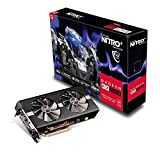 Sapphire Radeon RX 590 Nitro +, Graphics Card, 8GB GDDR5, ...
Sapphire Radeon RX 590 Nitro +, Graphics Card, 8GB GDDR5, ...
- various
- GPU frequency up to 1560 MHz, Boost
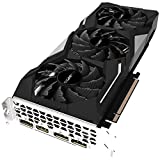 Gigabyte Aorus GeForce GTX 1660, Scheda Grafica, 6 GB-GDDR5,...
Gigabyte Aorus GeForce GTX 1660, Scheda Grafica, 6 GB-GDDR5,...
- Displayport 6 GB ram gddr5 con 8002 MHz
- Clock gpu base 1530 mhz / clock gpu boost 1860 mhz nvidia geforce gtx1660 gaming overclocked interfacce hdmi
Configuration from> 2000 € - 4K here I am!
With this figure you will have access to two very powerful cards: the RTX 2070 here in customization Asus Strix and going up the price RTX 2080 in version MSI Gaming Trio. In fact, these two cards will be able to let you play and work even with high resolution screens of 2K 1440p in the case of the 2070 and even 4K with the 2080, with details always at maximum and frame rates almost never below 80 / 90fps depending on the games.
Like the 2080 I also point out the AMD Radeon VII in the reference version, which guarantees practically the same performance. Obviously, the argument is always valid that by lowering resolution and details we will gain fluidity.
 MSI V372-031r NVIDIA GeForce RTX graphics card ...
MSI V372-031r NVIDIA GeForce RTX graphics card ...
- Memory: 8GB GDDR6
- PCI Express x 16 3.0
- Memory interface: 256-bit
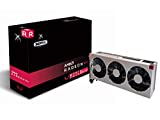 XFX AMD Radeon VII 16 GB HBM2, 1750 MHz Boost, 1801 MHz di...
XFX AMD Radeon VII 16 GB HBM2, 1750 MHz Boost, 1801 MHz di...
- Chipset: AMD Radeon VII
- 2GB HBM16 memory.
- Magnification clock: 1750 MHz.
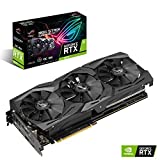 Asus ROG Strix GeForce RTX 2070 OC Edition 8 GB GDDR6,...
Asus ROG Strix GeForce RTX 2070 OC Edition 8 GB GDDR6,...
- Axial-Tech fans: dedicated design for better airflow and better acoustic comfort
- 0dB technology: absolute silence in the absence of heavy loads
- Auto Extreme technology: fully robotic construction for excellent reliability
€ xxx configuration - Captain, I see an FPS tsunami approaching!
Here we are at the higher end, the one in which the cost has a relative value, the one in which "okay, I take my holidays at home that I have listened to JapanTomato so much and I made myself a beast of gaming computers"!
If in the previous range there was still room for AMD solutions, in this the dominance of Nvidia is almost total and we can only recommend the two most powerful cards on the market: the RTX 2080TI here in the brightly lit version Gigabyte Aorus Extreme and the exorbitant reference Nvidia RTX Titan.
Two cards with respectively 11 and 24GB of GDDR6 VRAM, 4352 and 4608 CudaCore with frequencies above 1500 and 1700mhz. If all these data tell you little, know that to play in 4K with 120hz monitors and always maximum details these two cards are the only way.
However, it must be said that in reality the Titan has a slightly different specialization from that of gaming and is aimed more at researchers and professionals with ultra-professional workstations and the price of € 2749, represents double compared to the 2080TI which can still be considered a already professional level card.
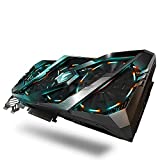 Gigabyte GV-N208TAORUS X-11GC scheda video GeForce RTX 2080...
Gigabyte GV-N208TAORUS X-11GC scheda video GeForce RTX 2080...
- Excellent quality product, reliable material
- Product created for both enthusiasts and professionals
- Useful and practical product
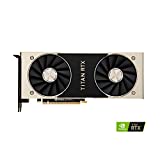 Nvidia Titan RTX TITAN X Scheda grafica 24756 MB
Nvidia Titan RTX TITAN X Scheda grafica 24756 MB
- Operating system certifications: Windows 7 (64 bit), Windows 10 (64 bit) (update April 2018 or versions ...
- NVIDIA CUDA 4608 cores running at 1770 MegaHertZ boost frequency; NVIDIA Turing architecture.
- 72 RT cores for ray tracing acceleration.
Ok Space Cowboy, even today we have reached the end. If you have not already done so, I invite you to read the previous articles that you find above at the beginning of the article and I renew the appointment with the next chapter entitled: Power supply and other peripherals. Often we don't think about it but ...
See you next week!
Mata neither !!


























